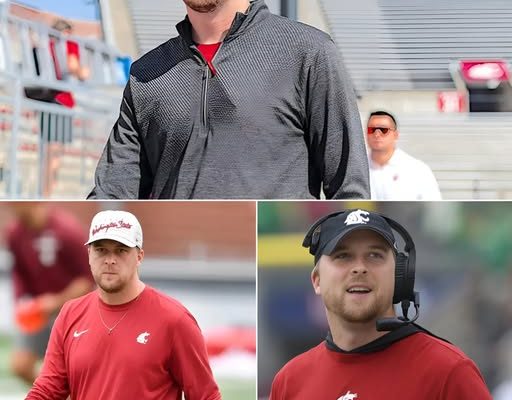Oklahoma offensive coordinator Ben Arbuckle has always been known for his aggressive offensive philosophy, but his latest directive to his wide receivers and the message he’s sending about quarterback John Mateer’s role has ignited a new level of energy around the Sooners program. In a sport where calculated risks and disciplined execution define success, Arbuckle’s approach appears to be pushing the boundaries of traditional offensive thinking. His mantra to his wideouts—“Go take it”—is more than a motivational quip; it’s a challenge, a demand, and a declaration of intent that embodies the high-octane, pass-heavy Air Raid philosophy. The fire in Arbuckle’s tone isn’t about empty hype—it’s about establishing a mentality that fits perfectly into the identity he wants for this offense.
In Arbuckle’s mind, the Air Raid isn’t just a playbook—it’s an attack plan. The scheme thrives when receivers aren’t waiting for opportunities to come their way but instead are actively creating them. By telling his wide receivers to “go take it,” Arbuckle is instilling a mindset that the ball is theirs before it’s even thrown, that separation is something they own, and that every snap is a chance to tilt the game in Oklahoma’s favor. He wants playmakers who aren’t afraid to challenge defenders, test coverages, and assert themselves in contested situations. This is a major mental shift from more conservative passing games that emphasize avoiding mistakes above all else. Arbuckle isn’t looking for passive participants—he’s looking for hunters.
The other piece of this puzzle is John Mateer, the quarterback Arbuckle appears committed to building around. While the quarterback competition at Oklahoma often draws headlines, Arbuckle has made it clear through his words and actions that Mateer is not just the guy under center—he’s the centerpiece of this offensive vision. The Air Raid is a system that demands a confident, decisive quarterback who can read defenses quickly and deliver the ball with precision. Mateer’s command of the offense, understanding of route concepts, and chemistry with his receivers have convinced Arbuckle that this is the man to run the show. His willingness to lock in on Mateer sends a strong signal to the entire roster: this is our leader, this is our identity, and we’re all going to rally around him.
What makes Arbuckle’s messaging so effective is that it ties the quarterback and receiver units together. In an Air Raid offense, the connection between QB and WR isn’t just about mechanics—it’s about trust. A quarterback has to believe his receivers will be exactly where they’re supposed to be, and receivers have to believe their quarterback will deliver the ball on time and on target. By establishing Mateer as the undisputed leader, Arbuckle is removing any uncertainty that could hinder that trust. When Mateer drops back, his wideouts know exactly who’s delivering the ball and exactly how he wants them to attack a defense. That clarity can be the difference between a completion and a wasted play.
For the receivers, Arbuckle’s “go take it” mentality is liberating but also challenging. It’s liberating because it frees them from the fear of making mistakes—they’re being told to be aggressive, to test their limits, to seize control of the game. It’s challenging because it removes excuses. If a ball is in the air, Arbuckle expects them to come down with it. If a defender is in tight coverage, he expects them to find a way to create space or win the contested catch. That’s the kind of accountability that turns good receivers into great ones. Players who embrace that standard often find themselves becoming more than just targets—they become playmakers who change the outcome of games.
This kind of offensive mindset also fits into Oklahoma’s broader goals for the season. In a Big 12 landscape where shootouts are common and explosive plays can swing momentum in an instant, having an offense that thrives on aggression can be a game-changer. Arbuckle understands that the Sooners’ path to dominance isn’t just about controlling the clock or methodically moving the chains—it’s about putting constant pressure on defenses, forcing them to defend every blade of grass, and striking quickly when opportunities present themselves. The Air Raid thrives when defenses are worn down mentally and physically by the pace and variety of passing attacks. Arbuckle’s directive to his wideouts is a way of weaponizing that philosophy.
The confidence in Mateer also has ripple effects beyond just the passing game. When a quarterback is firmly established as the leader, it stabilizes the entire offensive unit. The offensive line knows exactly whose cadence they’re working with and can focus on protecting him without the uncertainty of rotating quarterbacks. The running backs understand the rhythm of the offense and how their roles in pass protection and checkdowns fit with Mateer’s style. Even the coaching staff benefits, as play designs and adjustments can be tailored specifically to Mateer’s strengths without having to split focus.
Arbuckle’s background in the Air Raid system gives him credibility when making these kinds of bold statements. He’s worked with quarterbacks who have thrived in this style of play, and he understands that the best versions of the Air Raid aren’t just about scheming receivers open—they’re about empowering them to win on their own. That’s why his message resonates so strongly. He isn’t just telling receivers to run their routes—he’s telling them to attack every rep like it’s the most important play of the game.
The Sooners’ receivers seem to be buying into the philosophy. Reports from practice indicate that they’re attacking the ball more aggressively, fighting through contact, and showing improved timing with Mateer. There’s a noticeable shift in energy, as players aren’t just waiting for plays to develop—they’re actively seeking ways to create them. The competitive spirit is palpable, and that’s exactly what Arbuckle wants. When players compete at that level in practice, it translates to game day in the form of fearless play and relentless effort.
Of course, adopting an aggressive mindset comes with risks. The Air Raid, especially when paired with a “go take it” mentality, can lead to turnovers if players are overly aggressive or force plays that aren’t there. Arbuckle knows that, but he seems willing to accept that risk in exchange for the rewards it brings. His philosophy is that mistakes can be corrected, but timidity cannot be coached out of a player. He’d rather see a receiver challenge a defender and fail than run a timid route and take themselves out of the play entirely. That aggressiveness, when channeled correctly, can be devastating for opposing defenses.
As Oklahoma’s season approaches, the combination of Arbuckle’s leadership, Mateer’s stability, and the wide receivers’ aggressive mindset could define the team’s offensive identity. The Sooners have the personnel to thrive in this system, but what’s just as important is the mentality they bring to the field. Arbuckle’s message is clear—don’t wait for opportunities, create them. Don’t hope the ball comes your way, go take it. And above all, play with the confidence that your quarterback believes in you and that your coordinator has built an offense designed to let you shine.
If the Sooners can execute that vision, the Air Raid won’t just be a scheme on paper—it will be a living, breathing attack that overwhelms opponents and reestablishes Oklahoma as one of the most feared offenses in college football. In a conference where big plays win games, Arbuckle’s fire and Mateer’s command might be the combination that takes Oklahoma from dangerous to unstoppable. The challenge has been issued, the leader has been named, and now it’s up to the Sooners’ playmakers to prove they can go take it.



